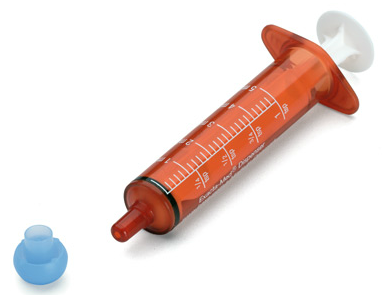 The distribution process in pediatric acute care can be quite a bit different than its adult counterpart. The basics are the same on the surface: 1) receive medication orders, 2) fill medication orders, 3) dispense medications. The big difference however is how those medication orders are filled. Pediatric patients require a lot medications in liquid form pulled into oral syringes with patient specific dosages. The bummer is that a vast majority of these syringes are not manufactured in unit of use syringes. In other words you have to do most of the work yourself. It’s a bit of a hassle, but it has to be done. The process of pulling liquid doses into oral syringes has more in common with work done in the IV room than it does with traditional oral solid distribution.
The distribution process in pediatric acute care can be quite a bit different than its adult counterpart. The basics are the same on the surface: 1) receive medication orders, 2) fill medication orders, 3) dispense medications. The big difference however is how those medication orders are filled. Pediatric patients require a lot medications in liquid form pulled into oral syringes with patient specific dosages. The bummer is that a vast majority of these syringes are not manufactured in unit of use syringes. In other words you have to do most of the work yourself. It’s a bit of a hassle, but it has to be done. The process of pulling liquid doses into oral syringes has more in common with work done in the IV room than it does with traditional oral solid distribution.
Recently I was visited a pediatric hospital and watched this process in action. Based on what I witnessed I started to wonder if it was possible to automate the process. And if you could automate it, would it offer any benefit? I suppose it could increase the safety of the process as well as potentially eliminate the need for a pharmacist, freeing them to do something else. Maybe. Maybe not. Regardless, it was worth more thought.
I started breaking down the process and realizes that it’s more complex than it appears on the surface; it always is. Automating the process would be difficult. Several pieces of the puzzle are already available today, but as completely disparate systems.
Just thinking out loud, or in writing as the case may be, the process would look a little like this:
- Gather the information. The pharmacy system provides a lot of information for the process: patient demographics, allergies, etc., along with drug, dose, concentration, etc. This can all be tied to a barcode on the patient label, i.e. scan the label and you know what you’re supposed to have in your hand. The barcode is basically tied to the same information that a pharmacist sees when they look at a label.
- Fill and label the syringes. This is where I see the biggest gap. There are systems to fill syringes, but they really aren’t automated. They require human intervention to move the syringes, fill the syringes via a pump, label the syringes, etc. This piece of technology would have to be designed and built. I talked about one of these manual devices back in September 2010 when I wrote about the Baxa Repeater Pump.
- Filled syringe with label is now available for the check process. Based on the information tied to the syringe barcode from step #1 above you know who the medication is for, what medication is in the syringe, how much of the drug is supposed to be in the syringe, i.e. the dose. And so on.
- Perform a check for correct drug and correct dose. Automated scan of the syringe barcode, which gives the system reference to drug and reference to dose (volume).
- Verify drug – use something like SEA Medical Systems IV Check. Take a small sample of the drug in the syringe and perform a real time analysis. If it’s correct keep on trucking. If not, the system rejects the syringe.
- Verify dose (volume) – use camera system to verify volume (see video below). Real time volume verification. If correct keep on trucking. If not, the system rejects the syringe.
- Catalog the syringe for audit, recall, etc. There are several systems that could photograph the final product and archive the photos for easy access. I would imagine something like what DoseEdge does with oral syringes today, but a little more automated, i.e. syringe rolls by the camera, photo snapped, stored. This could potentially be rolled into the check process during the volume verification phase.
- The syringe has been filled, labeled, checked and cataloged. Now all that has to be done is combine the patient specific doses into a single patient specific package. Match barcode on bag to barcode on syringes; patient information only.
- Seal bag. We used to do this with controlled substances all the time. We used a heat sealer that sealed the bag and disposed of the waste. It’s a very tidy way to do it.
- Done. Doses are packaged into unit of use syringes and all syringes for each patient are packaged for dispensing.
As you can see, most of the technology to do this already exists, but they’re not necessarily compatible. Not to mention that there are a couple of potential holes in the system, namely step #2. Overall I think it’s entirely possible. The question is would anyone want it or use it?
Leave a Reply